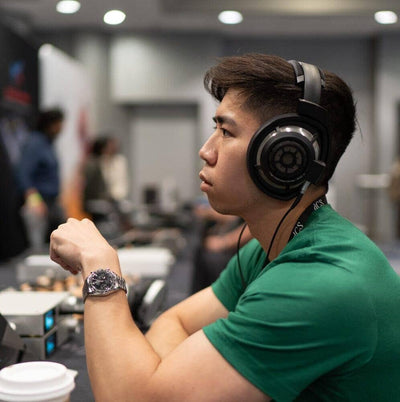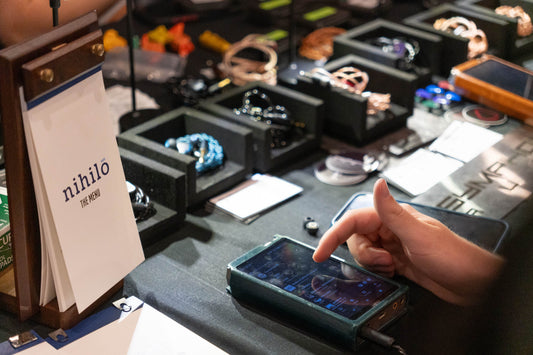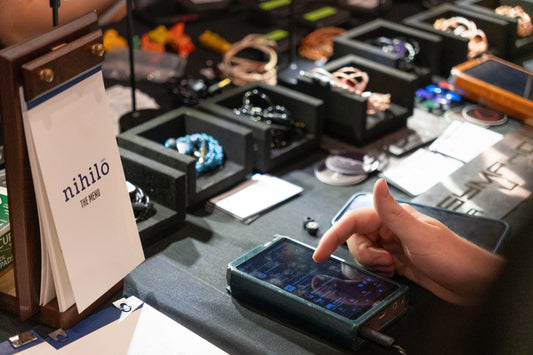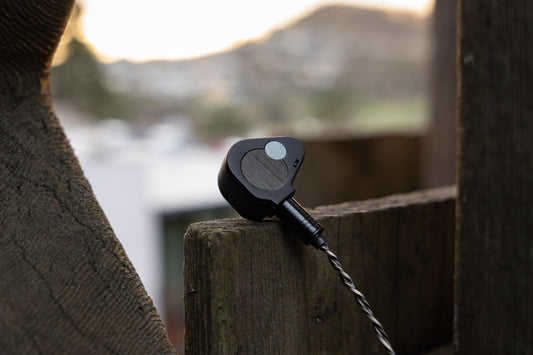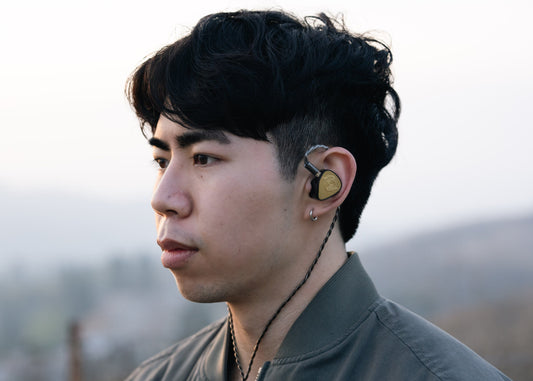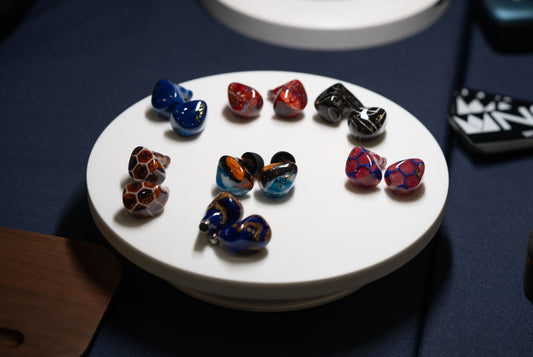Theo Lee
Theo, who reviews under the handle Precogvision, entered the world of audio as a freshman in college. An innocuous, window-shopping session online piqued his interest in a pair of IEMs (in-ear-monitors). At the time, he knew these as little more than the specialized earphones that musicians used. But reading the plethora of gushing reviews with audiophile lingo - words describing the sound that he didn’t understand, but that were undoubtedly positive - he decided to purchase a pair. He hated these IEMs.
After being burned once, and then surveying the landscape of the reviewing scene, Theo saw an opportunity to do better. The first few months entering the scene were an uphill battle, but Theo was able to leverage previous writing experience. Around this time, he also discovered an audio community on Discord where many listeners, like himself, were dissatisfied with the status quo. It was in this community that he happened to cross paths with Taron Lissimore of Headphones.com. When it was clear that their interests and values aligned, Theo was brought onto the team in August 2020.
In the last couple years since joining the team, Theo has quickly built a reputation for his honest, critical reviews. He also graduated college in April 2022. While he now has a full-time role in healthcare data analysis, he continues to write and film reviews for the team as a specialist in IEMs.
Some General Beliefs in Audio
Something you might note below is my copious use of “does not significantly influence.” I am not willing to completely rule out some popular audiophile remedies even if, by the science, they should not make meaningful differences. This is 1) based on my personal experience, and 2) a matter of principle that stems from the belief that the current science doesn’t hold all the answers to how we perceive sound.
In any case, here are my beliefs on some popular audiophile topics!
Burn-In: It's not that I don't necessarily believe in the idea of burn-in, as there are sometimes small, ~1dB shifts in frequency response measured between a "fresh" and "burned-in" set. But more closely, it's that my experiences with burn-in have been almost unanimously negative anyways. Realistically, I can't perfectly remember what I heard the last time I heard a set before burning it in for comparison. Those shifts in FR are also almost inaudible, which means that it's more a matter of psychoacoustics or "brain burn-in" for me. In that vein, I swap between separate sets often enough that I normally end up further disliking a set that didn't grab my attention in the first place. Or I get bored/fatigued of a set that grabbed my attention initially. This is reflected in my reviews which are almost always more critical than my first impressions.
Frankly, I dislike the practice that some manufacturers have of suggesting burn-in time with their IEMs. It's a game where they have nothing to lose, and it promotes an element of ambiguity that can be used to lead new listeners, or listeners who didn't like an IEM out of the box, astray (e.g. "you didn't burn the IEM in enough yet"). Newer listener's ears often don't acclimate to new sounds as quickly, so it's predominantly (again) a psychoacoustic effect - sensory adaptation - where, for example, peaks that were initially painful to hear become their new baseline for normal. Suggesting burn-in time is also just a lazy practice. If a manufacturer really cared, they'd burn-in the set themselves at the factory.
Cables: I do not believe that cables significantly influence an IEM’s sound. I think that to a small extent they may audibly shift frequency response, often via impedance, or intangibles via better shielding. But cable swapping to make better an already poor-sounding IEM is mostly an exercise in futility.
Power: I do not believe that sources or “more power” significantly influence an IEM’s sound. I absolutely believe in differences of sound between sources; however, they tend to be very minor to my ears. Generally, the only instance with which I have found “more power” to make a meaningful difference with IEMs is some that use ESTs. This is simply because these IEMs do not have the ESTs implemented correctly.
Ear tips: I believe that tips affect an IEM’s sound. Unequivocally. However, those differences tend to be minor; this is measurable. So for me, it’s more along the lines of “I don’t care enough to use anything outside what the manufacturer provides for reasons of consistency.” When you introduce aftermarket tips into the equation, there’s suddenly way more things to deal with! At what point do you stop testing tips? Someone is always going to tell you, “Oh, you didn’t test this, so your impressions are invalid.” And what if there is an IEM that’s make it or break it with a certain pair of tips? Am I supposed to tell people, “Well, shoot, you need to buy X tips with this IEM or else you effectively have a paper weight.” I’d certainly hope not. And if you did need to, I’d argue that’s a problem with the IEM itself more than anything. It’s the same idea with sources which, again, I absolutely believe make an audible difference. While tips are lower hanging fruit, there’s only a certain amount of leeway that I can afford an IEM, and (for me) this stops at the assortment of tips that a manufacturer provides.
The Test Tracks
I think it’s pretty well-established that I do not particularly believe in transducer-to-genre synergy. My logic is that because there are so many possible variations and subsets of songs within a given genre, this means that when someone says that a transducer works well with a certain genre, they are effectively generalizing (something I’m no doubt guilty of doing nonetheless). I would prefer to avoid doing that when possible. However, I definitely believe that certain songs sound better with certain transducers, and hopefully this can lend more context to where I’m coming from when it comes to my writing.
Something you’ll notice is that the moment I am listening for in a given track tends to be near the beginning. The main reason for this is because aural memory is highly fallible. Especially when I’m running A/B comparisons, I don’t want to be wasting time moving around the slider to a specific part of the song on top of swapping the IEMs. Additionally, my goal (especially at shows) is usually to ascertain an IEM's frequency response, or at least get a rough idea which guides my thoughts, as quickly as possible.
Bass
Trivecta, Wooli, Seven Lions – Island (feat. Nevve): The part that I am listening for here is from 2:23 to 2:50 which features Wooli’s drops. His drops have a very distinctive characteristic to them. They lean dark, rich, and with a touch of messiness. They are some of the hardest hitting drops that I have heard in EDM, and it is very easy to tell when a transducer is not slamming properly on them. The drops hit in quick succession too. A characteristic that I will often listen for is how a transducer is able to transition from drop to drop. Some transducers are able to scale the nuance of the drops, but they don’t sink as deeply or with as much aplomb as they should.
Dreamcatcher – Can’t get you out of my mind: The bassline of this track has a thick, almost “moist” characteristic with good bounciness. This also indicates pretty quickly the level of sub-bass focus an IEM has.
Illenium - Broken Ones: The thumps that start at 0:18 are usually my go-to for gauging an IEM's bass quantity and the general balance between sub-bass and mid-bass. This probably isn't the best track for this (I've had some misleading impressions with this track, as it's more mid-bass focused) but I've listened to the track hundreds of times and it's just a satisfying listen for me.
FareOh – Run Away: This track opens with deep, slow bass hits from 0:06 onwards. This is a good test of bass decay, or how long a transducer allows a note to bloom. I feel that these bass notes also capture the sub-bass frequencies pretty closely, so this is a good test of extension.
Aimer - Even Heaven: This track is a good test of bass extension, especially in the thumps that begin at 0:15. You should be able to really 'feel' the bass tickle your ear drums as the thumps token the 30-40Hz range. Hans Zimmer - Why So Serious? is another classic track that goes even lower, I believe as far down as 20Hz, starting at 3:26. However, I find that it's more difficult to gauge bass quantity with this track because of how low it goes.
Midrange
Joe Nichols – Sunny & 75: I grew up listening to Nichol’s music; he has a great voice and, thankfully, he doesn’t sound like a robot on this track (I really liked his hit single in 2009, “Gimmie that Girl,” but the mastering was horrible). All I’m really listening for here is the lower-midrange. Transducers with lots of sub-1kHz presence will usually make his voice sound overly thick and blobby. This might also indicate a lack of pinna compensation or upper-midrange, although that’s more difficult to tell with just this track.
Keith Urban – Kiss a Girl: The only part I’m concerned with here is the opening electric guitar in the right channel, and then the one shortly after in the left channel. This is a very easy way to tell if there is a 3-4kHz recession or lack of pinna compensation. Transducers that recess this region too much will lose bite and the guitars’ tasteful sense of crunch.
Tim McGraw – Don’t Take the Girl / Alison Krauss – When You Say Nothing At All: I think McGraw’s voice has changed over the years, but you can definitely hear traces of nasality in this track. Transducers that have a bump at 1kHz tend to sound boxy and exacerbate this nasal quality. On the other hand, Allison Krauss has a really nice voice that has often been described as “angelic.” BA IEMs, for example, tend to make her voice sound gritty. Generally speaking, these are also both darker, slower tracks which might work well with the tonality of certain transducers but not others. IU’s – Blueming is another example of a vocalist with a smooth taper to the way her voice decays.
Taeyeon – I: Taeyeon has a vibrant timbre to her voice in the opening. She should sound like her voice is almost glowing. This is usually my gauge for how much pinna gain an IEM has. The reason her voice sounds so vibrant is also because it's supported by the upper-treble frequencies, so I can usually get a quick sense for how much upper-treble (10kHz+) an IEM has from this alone.
Loona – Eclipse: I’m really only concerned with the opening. The vocalist, Kim Lip, has a tendency to exhibit sibilance on the lyrics, “I feel sparks,” with the last word’s “s” consonance. Too much lisp to this consonance indicates to me that I’m dealing with an upper-midrange oriented IEM that doesn’t slope off adequately at ~3kHz. This is also what I usually use to evaluate the transition from 3-5kHz (upper-midrange to lower-treble for me). Kim Lip has a tendency to sound like she’s stuck in head-voice when a transducer’s transition from 3-5kHz shifts upwards. Danielle Bradbery & Thomas Rhett’s – Goodbye Summer is another track that I often use to test this transition. Danielle Bradbery’s voice has a very light, delicate balance that’s easy to throw off.
Treble
Girls’ Generation – Into the New World: This is a classic K-Pop track with lots of brightness. From 0:10 to 0:27, you can hear plenty of stick impact in the center channel. This is a quick way for me to assess if there might be a peak from 5-6kHz. A peak at 5kHz often represents itself with a certain “chalkiness” to the way the hit is articulated, like chalk being scraped upon a blackboard. A peak at 6kHz tends to sound more correct, just sharper. A wide-band elevation from 5-6kHz will generally present itself with a good sense of “weight” to these percussive hits. This track is also a way for me to assess transient speed and layering. The percussive hits from 0:10 to 0:27 hit in quick succession, and a transducer should have good distinction between each hit. There’s also good amounts of shimmer and sparkle to the backdrop going on which a transducer should be capturing; this is indicative of both extension and detail retrieval. A good example of micro-dynamics is when Soo-Young enters after Taeyeon at 2:23; her voice sounds noticeably more subtle and quiet contrasted to the volume of Taeyeon’s.
Tim McGraw – Thought About You: There is a persistent ~15kHz whine in the right channel all throughout the opening of this track. Don’t ask me what they were thinking when they mastered it like this, but it’s a quick way to tell if a transducer has adequate extension. Some IEMs that peak here will make this sound overly fatiguing too.
Soundstage & Imaging
Sawano Hiroyuki – Binary Star (ft. Uru): Sawano Hiroyuki’s tracks frequently play with staging, and there is a lot of ambiance to the opening of this track; it sounds oh-so-open. This is mainly useful for A/B purposes because it sounds more open than your average track on most transducers you listen to anyways. As it progressively gets busier, though, it makes for a good test of general layering ability. The violins from 2:58 to 3:20 are another good indicator of a transducer’s presence regions. If they fall back into the mix too much, that usually indicates a recession at 3-4kHz.
Taeyeon – Fine: I’ve talked about this track a lot before, but this remains a personal favorite for testing center image distinction and layering. Taeyeon’s voice should be forward and upfront in this track. But 2:38 onwards into the last chorus has a series of vocal overdubs with which Taeyeon’s voice comes from all parts of the center image. If you listen closely on a good transducer, you’ll even notice that her voice comes from varying depths too. Transducers with poor imaging will often cluster these overdubs and make it impossible to tell where they are coming from in the center image. Listening for the sense of space between these overdubs is also a good way for me to discern separation.
Dynamics
Okay, this is somewhat awkward: I actually do not listen to a lot of music with high dynamic range. If I’m being perfectly honest, this is mainly because I do not think that the dynamic range of a track has much bearing on my enjoyment. As far as I understand it (obligatory “not an expert”), dynamic range simply represents the ratio between a given track’s lowest and quietest points; it is not necessarily a representation of the actual quality of the track’s mastering. I would go so far as to argue that some measure of compression is enjoyable, as it gives tracks a sense of fullness when done correctly. And yes, I’m well aware that this might be ironic given how heavily I index for dynamics in my writing. ¯\_(ツ)_/¯
Yiruma – River Flows in You (Orchestra Version): Here, I’m listening from 2:25 to 3:34. At 2:25, the song recedes into a quiet section; this is followed by a steady rise in volume until it peaks with the violins at 3:34. Ideally, a transducer should sound quiet at the quietest part and loud at the loudest part. A transducer that does this properly has good dynamic contrast, particularly for crescendo/decrescendo (gradual) dynamic swings.
Kenny Chesney – There Goes My Life: Kenny’s older stuff tends to be pretty well mastered and with robust dynamic range. I really like how the cadence of this track builds from 1:47 to 3:15. There’s also a lot of tasteful detail that’s been left in the mastering. At 2:19, for example, you can hear that particular hit on the drum jump in volume.
Sawano Hiroyuki – e of s (2V-ALK Version): The re-mastered version actually has less dynamic range than the original, which is this one. Parts I’m looking for here are the explosions into loudness, particularly the one from 2:40 to 2:55. At 2:40, the track is at peak loudness, at 2:49 the vocalist Mizuki’s voice drops slightly, then the cadence of the track itself drops shortly before exploding into peak loudness again. This is a good way, at least for me, to tell if a transducer scales dynamic swings quickly (or with what some might call sforzando).
Sawano Hiroyuki – Tranquility / A/Z (Remastered): I’m not as fond as the original versions of these tracks. You can tell they are smoothed over in the air frequencies and that they sound somewhat congested; this leads me to prefer the remastered versions even if they might technically be more compressed on something like the DR Meter. That aside, these tracks are good for getting a general sense of a transducer’s ability to carry “weight” or a sense of physicality between dynamic swings. Tranquility has transitions from 0:50, 2:04, and 3:38. A/Z has transitions at 1:10 and 2:55, plus sports a good amount of peak loudness.
